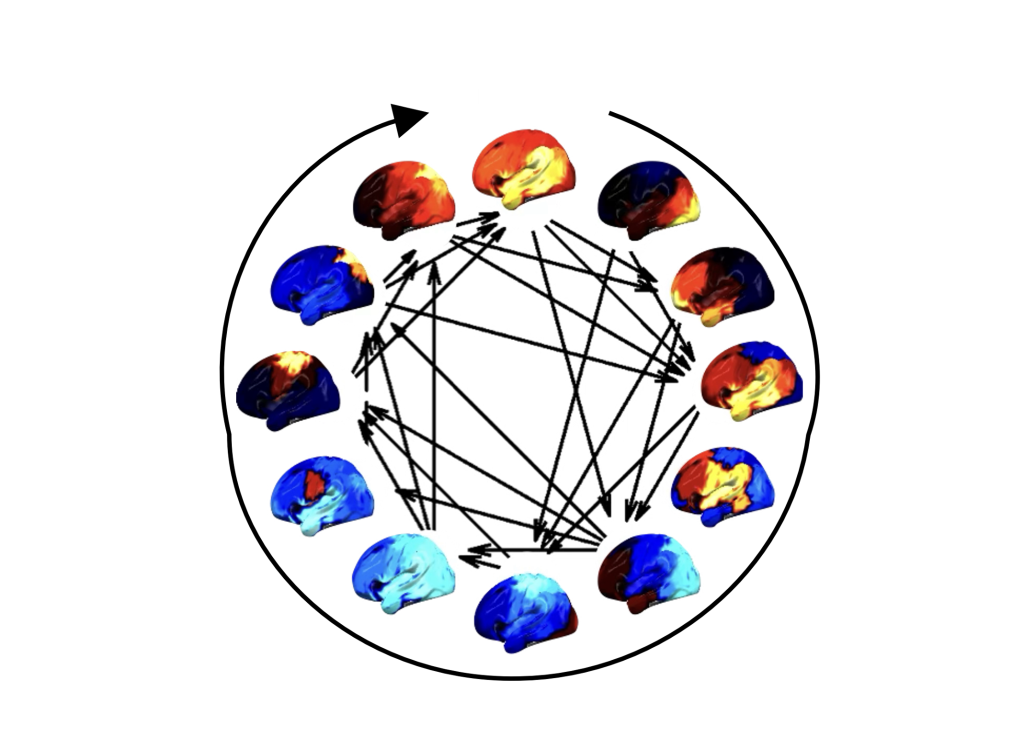Extraordinary Junior Research Fellow in Experimental Psychology Dr Mats W J van Es has published a new study about brain function in Nature Neuroscience. We asked him to tell us more about his findings.

Can you explain what you mean in your findings when you say that the brain has a “repeating rhythm” that organises thought?
The brain performs a diverse set of cognitive functions like attention, memory, and sensory processing, but because of its limited resources the brain cannot perform all cognitive functions at the same time. Instead, it needs to switch between cognitive functions while ensuring that 1) it remains flexible to a changing environment and 2) no cognitive function is forgotten. Our study found that the distinct brain networks that underly these cognitive functions activate in very fast repeated cycles (lasting about half a second), which may be the mechanism that coordinates cognition.
How does this finding change our understanding of how different parts of the brain work together?
A lot of neuroscience research in the last two decades has focussed on identifying which brain areas make up the networks that are crucial for a particular cognitive function. This has led to a lot of insight into the physiological building blocks of cognition, yet little is known about how they are coordinated. We have shown first evidence that these building blocks adhere to time-based rules.
You mention that the brain’s networks follow “organised temporal rules.” What surprised you most about these rules?
We were surprised by how robust the cycles are. The presence of the cycle and the order in which networks preferably activate was the same across datasets where people were simply resting but awake, and even in a computer task where people were bombarded with visual input. We had thought that the visual task would completely disrupt the cycle, but it did not! It was still present in the background and affected behaviour. We are now curious to find out how stable these cycles are in the same individuals doing different tasks.
How does this internal brain rhythm differ from more familiar rhythms such as circadian cycles?
Cycles are extremely common in biology, with the circadian cycle and sleep cycle being the most well-known. Our identified brain rhythm differs in two ways: 1) they are much faster – about half a second compared to 24 hours and 90 minutes for circadian and sleep cycles respectively; and 2) they are much more flexible because behaviour needs to more flexible, compared to many homeostatic functions that circadian and sleep cycles fulfil.
What was the moment you realised there might be a repeating cycle underlying all these networks?
We already knew there were preferred activation pathways between different networks. But only when we visualised all of these together and moved around the puzzle pieces, we were struck by the possibility that there may be an overarching rhythm. It took a lot of quantitative validation and replication in multiple datasets before we were convinced that this finding might actually be real.
Could understanding this rhythm lead to new treatments for neurological or psychiatric conditions?
We think it may be. A lot of neurological and psychiatric conditions show defects in specific brain networks. Knowing more about their timing may allow us to support or interfere with these networks, which has a lot of clinical potential. In fact, one of the co-authors of this study, Dr Cameron Higgins, has established a startup developing medical technology built on this finding.
How will being part of Queen’s support your next steps?
Every time I discuss this research at Queen’s, be it with other neuroscientists, historians, or economists, I get new ideas and am challenged about the assumptions I make and theories I have. It is a very stimulating environment that keeps me on my toes.
What excites you most about doing this research in an interdisciplinary setting?
Everyone brings different knowledge and skills to the table to work on a common goal that fascinates us all.
Header image: The distribution of activity in 12 functional brain networks embedded in their cyclical progression. Each brain map shows the relative increase (reds/yellows) or decrease (blues) in activity projected on to the left hemisphere. Each arrow indicates a preferred trajectory between networks.



